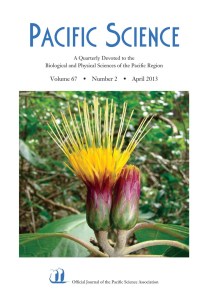 Biology and Impacts of Pacific Island Invasive Species. 9. Capra hircus, the Feral Goat (Mammalia: Bovidae)
Biology and Impacts of Pacific Island Invasive Species. 9. Capra hircus, the Feral Goat (Mammalia: Bovidae)
Mark W. Chynoweth, Creighton M. Litton, Christopher A. Lepczyk, Steve C. Hess, and Susan Cordell, 141–156
Domestic goats, Capra hircus, were intentionally introduced to numerous oceanic islands beginning in the sixteenth century. The remarkable ability of C. hircus to survive in a variety of conditions has enabled this animal to become feral and impact native ecosystems on islands throughout the world. Direct ecological impacts include consumption and trampling of native plants, leading to plant community modification and transformation of ecosystem structure. Although the negative impacts of feral goats are well known and effective management strategies have been developed to control this invasive species, large populations persist on many islands. This review summarizes impacts of feral goats on Pacific island ecosystems and management strategies available to control this invasive species.
Biology and Impacts of Pacific Island Invasive Species. 10. Iguana iguana, the Green Iguana (Squamata: Iguanidae)
Wilfredo Falcón, James D. Ackerman, Wilnelia Recart, and Curtis C. Daehler, 157–186
Green iguanas (Iguana iguana L.) have been introduced to many locations outside their native range due to both the pet trade and illegal introductions. This has led to the establishment of populations and subsequent spread outside the native range, causing negative impacts. The Pacific region is no exception, where green iguana populations have been reported historically in Hawai‘i and recently in Fiji and Ishigaki Island (Japan). Experience with I. iguana in the Greater Caribbean Basin has taught us that, if the right conditions are present, these reptiles proliferate and expand their range rapidly. We assessed the potential impacts that I. iguana may have on Pacific islands, especially where populations have been reported, and evaluated the risk of a green iguana invasion on Pacific islands using the maximum entropy niche-modeling algorithm (MaxEnt). The model predicted high climatic suitability for these reptiles on many Pacific islands, including those where populations have already been reported. Management and eradication strategies may include (1) targeting males during the reproductive season, when they establish territories and are displaying in trees; (2) finding females during the nesting season, when they are active on the ground and in vegetation at nearby nesting areas; and (3) finding nests and destroying eggs, or constructing artificial nesting areas to lure females. Green iguanas may be captured by hand or by pole-noose, with dogs, or shot with a 0.22 rifle. Where green iguanas are kept as pets, education campaigns are critical to prevent escapes. If possession is illegal, amnesty may be offered to owners who hand them in. Without proper regulation and management, I. iguana is likely to continue spreading and invading other Pacific islands.
Genetic and Morphological Differences among Populations of the Japanese Bush-Warbler (Aves: Sylviidae) on the Ogasawara Islands, Northern Pacific
Naoko Emura, Haruko Ando, Kazuto Kawakami, and Yuji Isagi, 187–196
Cettia diphone diphone is a subspecies of the Japanese Bush-warbler that is endemic to the Bonin and Volcano Islands of the Ogasawara Islands. Although the two island groups are physically distant and have different geological histories, genetic and morphological relationships between the two populations are unknown. A few individuals of an unidentified subspecies have been observed since 2007 on Mukojima of the Bonin Islands. They were possibly wintering birds of another subspecies in light of their song pattern and appearance. We examined the genetic and morphological differences among the Bonin and Volcano populations of C. d. diphone, C. d. cantans, and C. d. sakhalinensis populations and determined the identity of the unidentified subspecies on Mukojima by comparing sequences of the CO1 region of the mitochondrial DNA (mtDNA) and conducting a canonical discriminant analysis (CDA) using five measurements per bird. Our results indicate that these populations (except C. d. sakhalinensis) are genetically and morphologically different. They did not share any haplotypes of mtDNA and indicated high discrimination rates (over 75%) based on CDA. Because the Volcano population inhabits only one island, it is a priority for conservation. The unidentified individuals on Mukojima Island are not the native subspecies. Migratory individuals might colonize Mukojima due to improved habitat conditions and an available niche. Continuous monitoring of the Mukojima population and its impact on native C. d. diphone is required.
First Successful Introduction of the Golden Pheasant (Chrysolophus pictus) to the United States
Ruby L. Hammond, 197–203
The Golden Pheasant, Chrysolophus pictus (L.), was introduced to Maui, Hawai‘i, as recently as the mid-1990s and has been found at three locations on the windward slope of East Maui between 1,700 and 2,400 m in elevation. I contacted researchers, land managers, and hunting guides who worked in areas inhabited by Golden Pheasants from 1990 through 2012 and compiled their notes to determine the approximate time and location of introduction and range of the species, in addition to investigating the possibility of the establishment of the species on Maui. The species was probably released at Waikamoi Preserve, and detection frequency increased there since the discovery of the species in 1996. Evidence of reproduction during 2010–2011 suggests that a small breeding population is established at Waikamoi Preserve. Since the first detection in 1996, the linear range of the Golden Pheasant expanded to two additional areas, Hanawī Natural Area Reserve and Haleakalā National Park, encompassing a dispersal area of at least 10 km. Total area occupied by Golden Pheasants is estimated at around 40 ha at Waikamoi Preserve and 6.5 ha at Hanawī Natural Area Reserve.
Microhabitat Use in an Assemblage of Native and Introduced Fishes in a Hawaiian Stream
Mark G. McRae, Lori Benson McRae, and J. Michael Fitzsimons, 205–217
Ecological aspects of the relatively diverse fish assemblages found in the terminal reaches of streams in Hawai‘i are largely unknown. This study described patterns of microhabitat use in an assemblage of native and introduced stream fishes living in the terminal reach of Wailoa Stream on the island of Hawai‘i. Multivariate analyses of data collected through underwater visual surveys indicated that differences in microhabitat use were an important factor in structure of this assemblage. In riffle habitats, native fishes selected distinct microhabitats based on water velocity, substrate size, and position in the water column. In run habitats, a benthic guild (native gobies) and a water-column guild (introduced poeciliids and the endemic Kuhlia xenura) were identified. Strong differences in three-dimensional microhabitat use patterns appear to allow native gobioids to resist being displaced by introduced poeciliids in Wailoa Stream. However, high overlap in the microhabitat use patterns of juvenile K. xenura and introduced Poecilia mexicana and Xiphophorus helleri is cause for concern.
Evolution and Biogeographic Origins of the Endemic Hawaiian Genus Hesperomannia (Asteraceae)
Clifford W. Morden and Susan Ching Harbin, 219–235
The endemic Hawaiian genus Hesperomannia A. Gray was investigated to examine relationships among species and to test the hypotheses of dispersal to the Islands over 17 mya. Both nuclear internally transcribed spacer (ITS) sequences and random amplified polymorphic DNA (RAPD) markers were used to assess genetic divergence among populations and species. PAUP, Neighbor-Joining, and Bayesian phylogenetic trees were generated to examine species boundaries and relationships. Principal coordinates analysis was used to examine relationships among individuals within populations and genetic distances among populations. Analyses suggest that four species should be recognized: H. lydgatei, H. oahuensis, H. swezeyi, and H. arborescens. Sequence analysis is consistent with arrival to Hawai‘i as recently as the last 2.3 my, after the three main island groups (Kaua‘i, O‘ahu, and Maui Nui) had emerged, followed by rapid dispersal among them. O‘ahu species are more closely related to each other than either is to the species of Maui Nui as was previously hypothesized. In contrast, Maui Nui plants are not genetically distinct enough to warrant separate species as previously recognized. Long-distance dispersal is evoked for dispersal among distantly situated island groups, but there is no evidence that colonization followed the progression rule model of dispersal among the Islands and may have occurred from younger to older islands. Vicariance is probable within O‘ahu and among the islands of Maui Nui following erosion and subsidence of those islands, and may also explain distribution of species among O‘ahu and Maui Nui. A revised key to and diagnostic descriptions of the species of Hesperomannia are provided.
Phylogenetic Relationships among Endemic Hawaiian Lysimachia (Ericales: Primulaceae): Insights from Nuclear and Chloroplast DNA Sequence Data
Il-Chan Oh, Jürg Schönenberger, Timothy J. Motley, Kendrick L. Marr, Mattias Myrenås, and Arne A. Anderberg, 237–251
Sixteen endemic Hawaiian species of Lysimachia, formerly referred to as subgenus Lysimachiopsis, form a morphologically distinct and monophyletic group within the genus. This group has radiated in various habitats, and most species are endemic to a single island. To reconstruct phylogenetic interrelationships between the recognized taxa, we conducted phylogenetic analyses of 12 species of Lysimachia subgenus Lysimachiopsis using nuclear ribosomal DNA from two (ETS, ITS) and plastid DNA from five markers (rpl16, rpl20-rps12, rps16, trnH-psbA, trnS-G). A Bayesian analysis using all molecular data indicated that there are two major evolutionary lineages of Hawaiian endemic Lysimachia. The results also provide new insights into evolutionary history of the problematic L. hillebrandii/L. remyi complex, showing that L. hillebrandii and L. waianaeensis are closely related but that L. ovoidea is more distantly related and belongs to the other major lineage. Furthermore, L. remyi subsp. remyi and subsp. subherbacea are both closely related to L. maxima, but L. remyi subsp. caliginis and subsp. kipahuluensis belong to the second major lineage. Our results also indicated that earlier taxonomic treatments of the group need to be partially revised to reflect evolutionary relationships. A brief discussion on biogeography of the group is presented. The new combinations Lysimachia kipahuluensis subsp. caliginis and Lysimachia remyi subsp. maxima are made.
Patterns of Flower Visitation across Elevation and Successional Gradients in Hawai‘i
Jonathan B. Koch and Heather F. Sahli, 253–266
Numerous studies have examined foraging strategies of pollinators in continental landscapes, but relatively little is known about island pollinators. We investigated four native plant communities and their potential pollinators on Mauna Loa Volcano on Hawai‘i Island across two environmental gradients: elevation (middle and high) and succession (early and late). The effects of elevation and successional stage on visitation rates and degree of plant specialization were compared. Elevation had a significant effect on visitation rates with plants at mid elevation receiving the most visits, whereas succession had little effect on visitation rates. Both succession and elevation impacted plant specialization, with plants at late-succession and high-elevation sites being more specialized in terms of their diversity of flower visitors. Metrosideros polymorpha (Myrtaceae) received the most forager visits, even when it was not the most abundant plant flowering. Endemic Hylaeus bees (Hymenoptera: Colletidae) were the dominant visitors across all sites (64%–91% of visits), and endemic birds were observed only at mid elevation, primarily in the late-succession site. Considering the paucity of natural history studies on Hawaiian Hylaeus, further investigation of their potential role as pollinators of native Hawaiian plants is necessary.
Vegetation of Alejandro Selkirk Island (Isla Masafuera), Juan Fernández Archipelago, Chile
Josef Greimler, Patricio López, Karl Reiter, Carlos Baeza, Patricio Peñailillo, Eduardo Ruiz, Patricio Novoa, Alejandro Gatica, and Tod Stuessy, 267–282
We analyzed the vegetation of Alejandro Selkirk Island using the Zürich-Montpellier approach for taking relevés and subsequent classification by a multivariate approach and manual refinement. The resulting vegetation table demonstrates patterns of dominance and variation and the resulting vegetation units that were mapped onto aerial photographs to produce a vegetation map. Additional observations of several inaccessible sectors were gained from photos taken during a boat trip around the island. These results are combined in a colored map that shows the following vegetation units: (1) Dicksonia externa Tree Fern Community (upper montane forest); (2) Lophosoria quadripinnata Fern Community; (3) Fern-Grassland Mosaic; (4) Myrceugenia schulzei Forest (lower montane forest); (5) Anthoxanthum-Nassella Grassland; (6) Coastal Grassland with Juncus procerus; (7) Open Grassland (including Coastal Herb Communities); (8) Rocks, Erosional Zones; and (9) Cultivated and Escaped Plants Near the Settlement. In some cases these units consist of several communities together, often forming mosaic patterns where detailed resolution is not practicable. Unit 7, Open Grassland, has been applied to all areas with a plant cover below 40%, and unit 8, Rocks, Erosional Zones, indicates no or scarce vegetation (cover notably below 10%). Some plant assemblages cannot be shown on the map: (a) the small clusters of Drimys confertifolia; (b) the mostly linearly or patchily arranged Gunnera masafuerae community; (c) several plant assemblages found in the canyons; and (d) the Histiopteris incisa clusters between the tree ferns and tall ferns. We discuss composition of the observed plant communities, especially regarding alien impact, and compare our findings with those on Robinson Crusoe, the largest island of the archipelago.
The Ring Doesn’t Mean a Thing: Molecular Data Suggest a New Taxonomy for Two Pacific Species of Sea Hares (Mollusca: Opisthobranchia, Aplysiidae)
Jennifer Alexander and Ángel Valdés, 283–294
Morphological and molecular data obtained from Hawaiian sea hares identified as Aplysia dactylomela (Rang) and Aplysia pulmonica (Gould) revealed that they belong to the same species. Review of the literature shows that the name A. pulmonica has been used inconsistently, but the specimens we examined match the original description of the species. Two other closely related species, Aplysia kurodai (Baba) and Aplysia oculifera (Adams & Reeve), are distinct. In addition, Caribbean specimens of A. dactylomela are genetically and morphologically distinct from Indo-Pacific A. dactylomela. Because the name A. dactylomela was introduced for Atlantic specimens, it is here proposed that the name Aplysia argus (Rüppell & Leuckart) should be used for Indo-Pacific sea hares previously identified as A. dactylomela.
Rapid Reproductive Analysis and Length-Dependent Relationships of Lutjanus biguttatus (Perciformes: Lutjanidae) from Papua New Guinea
Ken Longenecker, Ross Langston, and Holly Bolick, 295–301
We describe a simple, inexpensive method for field-based histological analysis of fish gonads, and we used this method to describe the reproductive biology of the small snapper Lutjanus biguttatus from a remote area in Papua New Guinea (i.e., where laboratory equipment is limited and electrical service is lacking). We estimate male L50 at 13 cm FL and female L50 at 17 cm FL. Sex ratio is not significantly different from 1:1. There is no evidence for hermaphroditism. Fork length is a linear function of total length, FL = −0.1823 + 0.9647(TL), and weight is a cubic function of fork length, W = 0.0129(FL)3.0049. This information was generated during a 2-week period when the majority of our time was occupied by fish surveys. Our analyses were limited by availability of specimens (not processing time); therefore the methods we employed can help fill one of the information voids that preclude life-history-based management of coral-reef fishes.
Northern Distribution of the Seaweed Limpet Lottia insessa (Mollusca: Gastropoda) along the Pacific Coast
Evelyne S. L. Kuo and Eric Sanford, 303–313
The marine seaweed limpet Lottia insessa (Hinds) is a habitat specialist on the kelp Egregia menziesii along the northeastern Pacific coast. The geographic range of L. insessa is commonly reported to extend from Alaska to Baja California, Mexico, but the northern distribution of this limpet has been poorly documented. We examined L. insessa specimens from museum collections and surveyed distribution of this species in the field. Results indicate that this species is common in California but is rarely found farther north. Some museum specimens collected from northern localities were misidentified individuals of other limpet species. The northern limit to continuous distribution of persistent L. insessa populations ends at Cape Arago in southern Oregon, a known biogeographic boundary for a variety of marine species. We suggest that individuals occasionally found in the Pacific Northwest and Alaska may have been vagrants that were transported to those locations during anomalous oceanographic events such as El Niño−Southern Oscillations, a phenomenon that has also been observed in other marine organisms. This study clarifies location of the northern range boundary of L. insessa and provides baseline data on its current distributional patterns, which are important for assessing effects of climate change on potential range shifts in the future.
Association Affairs
315




